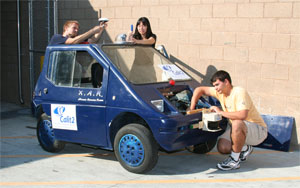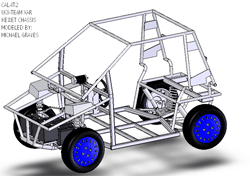UCI Student Team Sets Sights on DARPA Challenge
Oct. 27, 2006 – How’s this for a Cinderella story? Six talented, enthusiastic UCI graduate students, after years of hard work, beat overwhelming odds and send their autonomous car to the finals of the Defense Advanced Research Projects Agency (DARPA) Grand Challenge. Well … it could happen.
“Actually, we’re a little more realistic,” smiles Anton Popov, the student leader of Team XAR (eXtreme Anteater Racers), which has grown from an undergrad information-and-computer-sciences research project to a multiperson initiative with a full-fledged laboratory on the second floor of the Calit2 Building. “We want to get to the semi-finals, though.”
|
Applying techniques and skills gleaned from their ICS classes, Team XAR students – including Popov, Lorraine Kan, Chad Christenson, Michael Graves, Nick Mangano and Thomas Duerr – have worked diligently to construct an autonomous vehicle capable of navigating a 60-mile urban course in six hours, unassisted, while obeying traffic laws, avoiding obstacles and racing some 200 other teams’ challengers.
Setting the Pace
The DARPA Grand Challenge is sponsored by the U.S. Defense Department in hopes of automating one-third of military vehicles by 2015. The upcoming DARPA Urban Challenge takes place Nov. 3, 2007; Team XAR will submit its application over the course of several months beginning this month.
The more high-profile teams vying for the $2 million grand prize – including Stanford University’s Racing Team and Carnegie Mellon University’s Red Team – employ bewilderingly complicated technology and programming. Popov, however, believes Team XAR may have a better philosophy. “Our car won’t be nearly as complicated,” he says, explaining that “since we don’t have a lot of funding, we’re keeping it simple.” The thinking goes that a basic vehicle will be easier to maintain, build and most importantly, comprehend; as Team XAR adds more members, new recruits must be able to catch on quickly.
Popov estimates that 70 percent of the project’s hardware is complete, including electrical systems, actuators (brakes and steering), lighting, computers and a GPS navigation system. They’re just missing, well, a car.
|
Making a Pit Stop
Although passersby can see Team XAR’s 2005 autonomous car, a blue fiberglass contraption rigged with colorful equipment, in Calit2’s loading dock, it doesn’t meet weight, wheelbase and dimension requirements for the 2007 race. The students hope to upgrade to another vehicle this year; a SmartCar dealership is coming to California, and Popov is hopeful the business can donate a car and some engineering support.
Meanwhile, the team focuses on completing the vehicle’s software, which is designed as a “plug-and-play” system that can be used on any car. Using advanced research in sensor fusion – the process by which the car melds all of its sensory data into a single, guiding picture – navigation algorithms, control theory and an artificial intelligence neural network, they hope to “teach” their car to act as if it is being driven by a live person who perceives surroundings, and decides where to go and how to get there.
“The programming part is easy,” says Popov. “It’s just an issue of funding and time.” The car itself costs only about $20,000, but the team also needs to buy equipment ranging from cameras and computers to motors for the brakes and steering.
Calit2 provides more than half of Team XAR’s funding, along with UCI’s Undergraduate Research Opportunities Program (UROP) and the Ted and Janice Smith Family Foundation. Advisors Crista Lopes, assistant professor of information and computer science, and Isaac Scherson, professor of ICS and EECS, handle external relations, as well as some programming and electrical chores.
For the most part, however, the students are given free rein. “We basically have carte blanche to do whatever we want,” says Popov. Already busy with full course loads, each of the students puts in around 30 hours a week on the project.
They are hoping their hard work will be rewarded with an improvement over last year’s finish. In 2005, the team – which in addition to Popov, Kan and Christenson included since-graduated Titus Sanchez, Hrayr Artunyan, Hussein Sleiman and Phillip Schlesinger – was one of 118 to qualify for and pass the site visit, in which a DARPA official oversaw preliminary vehicle testing. The team hopes to make it to the National Qualifying Event in 2007, a semi-final of sorts that could add $50,000 in funding to their next attempt.
Another Lap to Go
Like many useful projects, however, Team XAR’s car isn’t just chasing prizes but also practical, real-life applications. The team is working with fellow Calit2 researcher Chris Davison, who specializes in emergency management technology, to adapt the car into a reconnaissance tool for scouting out disaster zones and other emergency situations, providing first responders with invaluable information. XAR also participates in the Blind Driver Challenge, which seeks to develop fully functional vehicles for the blind.
Although several team members have graduated, leaving Team XAR understaffed, Popov is confident they will be able to recruit more members. After all, he explains, “It’s been a really great experience, working with other people, designing things from the ground up and going all the way to implementing the design.
“At a company, you hardly ever see the results of your work. But here you get to see the results and be amazed.”


